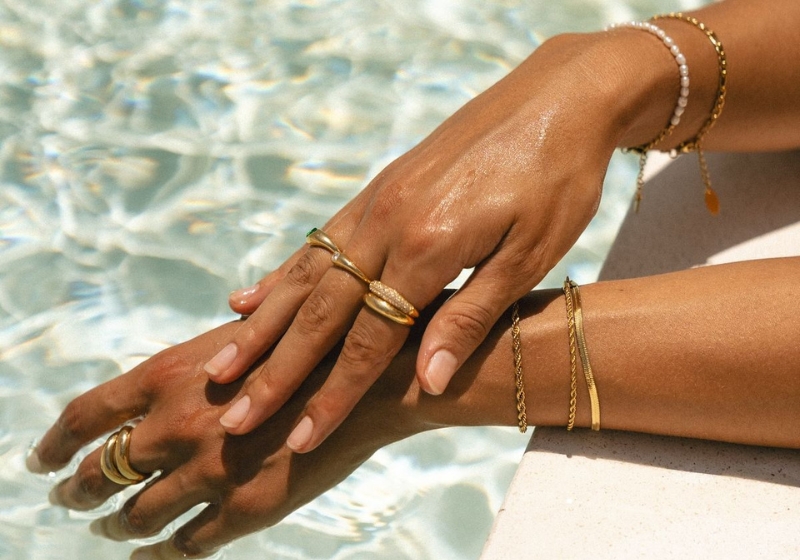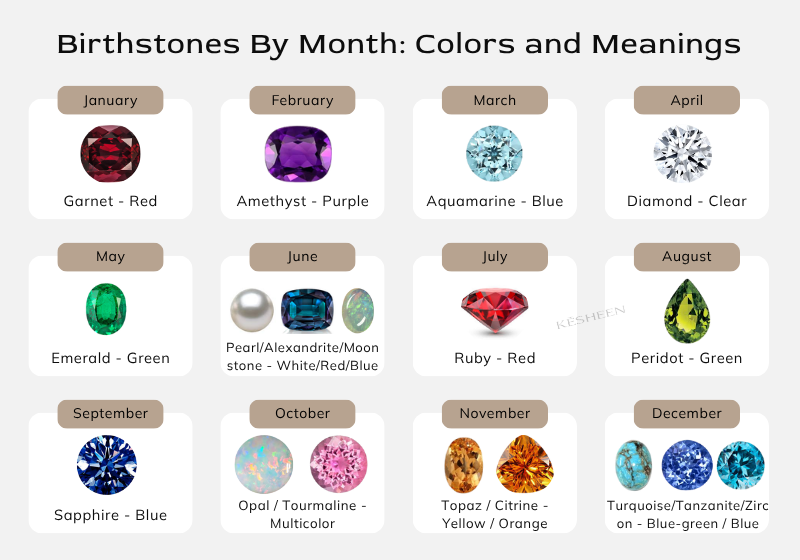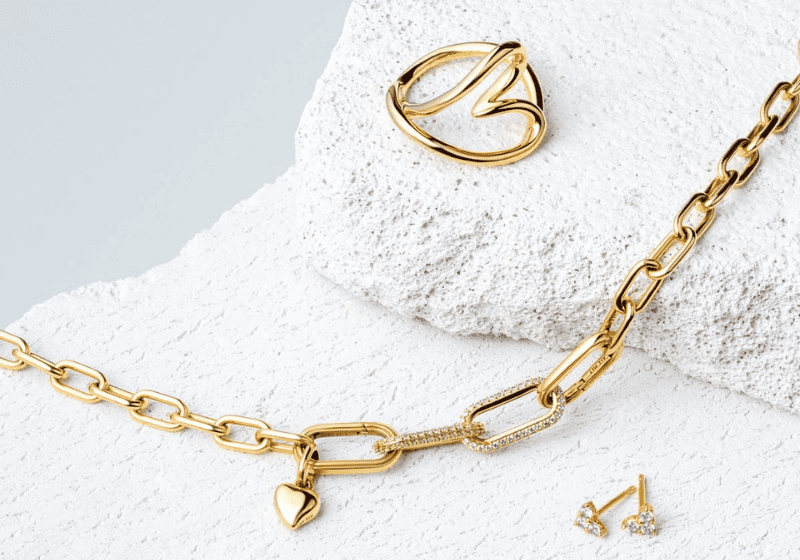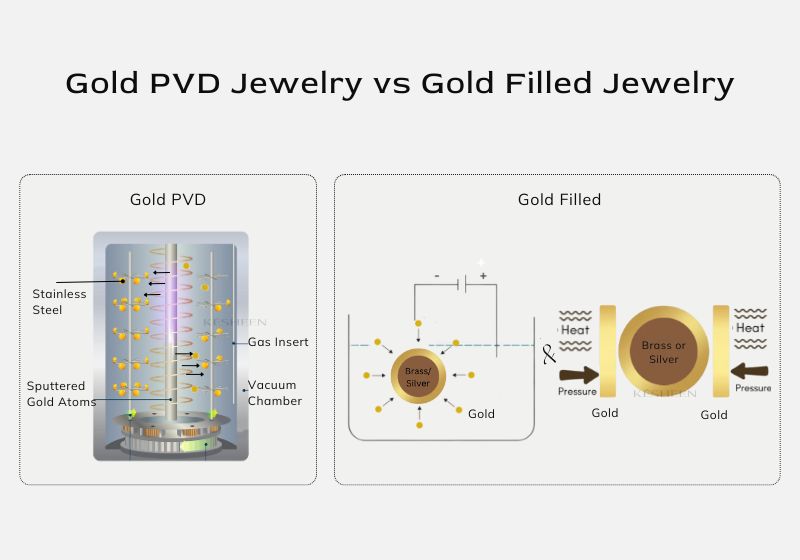Swimming in the pool or the ocean is fun—until your favorite jewelry starts to fade, tarnish, or rust. Wearing waterproof jewelry in the pool or ocean isn’t 100% safe. There are many other components in the pool and ocean that contribute to this effect.
Knowing what jewelry you can wear in the pool and ocean helps protect both its beauty and lifespan. In this article, we will dive deeper into the jewelry world, highlighting the ocean proof and pool safe jewelry you can trust.
Understand Pool Water & Saltwater and Its Effects on Jewelry
Let’s explore the hidden impacts of the pool and ocean on jewelry pieces:
- Chlorine: The Pool’s Hidden Threat
To clear the air: does pool water damage jewelry? Yes, the various chemicals added to the pool can cause significant damage.
The main chemical used in pools is “chlorine,” which is primarily used to clean the water. Thus, it’s advisable you enter the pool only with chlorine proof jewelry. If your jewelry contains even just a little alloy of copper or zinc, the chlorine reacts with it, making your jewelry lose its shine.
- Saltwater: The Ocean’s Unseen Threat
Does salt water damage jewelry? Yes.
Salt water contains salt and several abrasive minerals like magnesium, sodium chloride, and calcium that can ruin jewelry. The harsh nature of these minerals causes the jewelry to corrode quickly, leading to weakening and tarnishing.
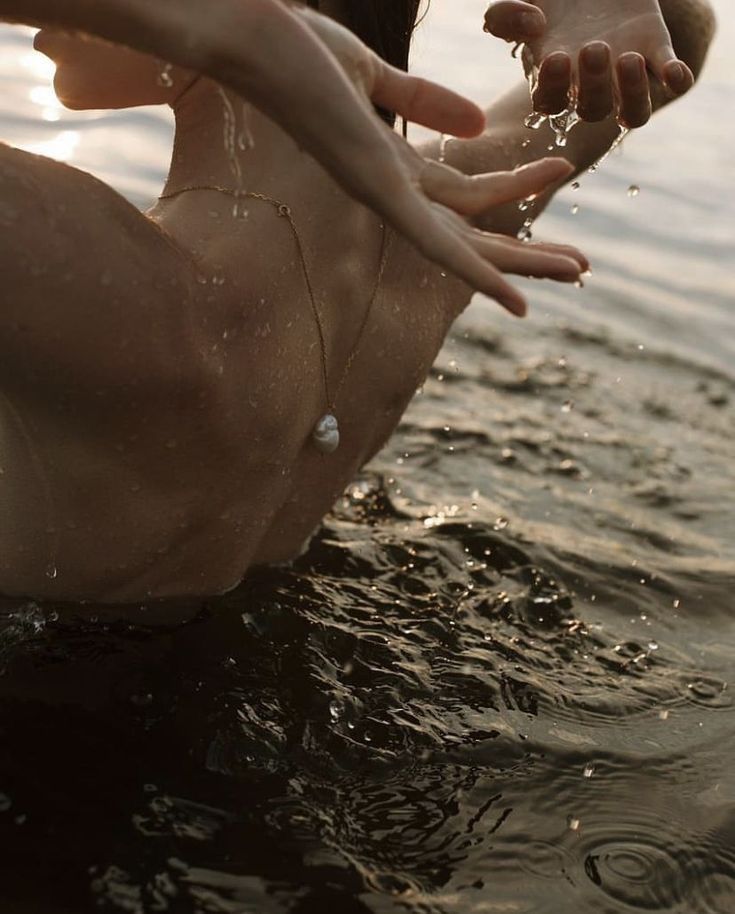
Comparison Table: Jewelry Materials in the Pool & Ocean
| Type | Pool Safe | Ocean Safe | Water Impact |
| Stainless Steel (PVD) | ✅ | ✅ | Highly resistant to corrosion, tarnish, and fading |
| Sterling Silver | ⚠️ | ⚠️ | Needs rhodium plating or e-coating to make it waterproof |
| Gold Plated | ⚠️ | ⚠️ | Depends on the plating layer, but should also avoid chemicals, shampoo |
| Gold Vermeil | ✅ | ⚠️ | Generally safe, but with caution, rinse & dry |
| Gold Filled | ✅ | ✅ | Generally safe, but with caution, rinse & dry |
| Solid Gold | ✅ | ✅ | Resistant to corrosion, tarnish, and fading |
What Types of Jewelry Can You Wear in the Pool?
The jewelry you can wear in the pool must be made with materials that can resist chlorine impact and maintain structural integrity. These types of pool proof jewelry materials include:
Stainless Steel Jewelry
Does chlorine affect stainless steel? Yes, chlorine can damage stainless steel over time.
However, stainless steel jewelry can be worn in the pool thanks to its chromium content, which forms a protective oxide layer that prevents corrosion. This jewelry has a non-porous surface that prevents chemical absorption, making it ideal for frequent swimmers who want durable, affordable jewelry that can withstand repeated chlorine exposure without compromising appearance.
PVD Coating Stainless Steel Gold Jewelry
PVD (Physical Vapor Deposition) creates jewelry you can swim in by depositing a gold layer ranging from 0.03-0.08 microns onto the stainless steel. When comparing PVD coating vs electroplating, PVD stands tall because the deposition process bonds at molecular levels, making the jewelry surface harder than traditional plating.
Is stainless steel gold fake? NO. The underlying stainless steel provides structural strength while the bonded gold offers decorative appeal and additional chemical resistance.
Sterling Silver Jewelry
Many people wonder: Can you wear sterling silver in the pool? It depends. Sterling silver without proper plating will tarnish quickly and can not be worn in the pool. However, sterling silver jewelry can survive pool exposure if it’s plated with rhodium and e-coated. The pool chemicals can make the surface darker, but with a simple wipe using a polishing cloth, the jewelry will become bright. However, it’s best that you only swim with this pool safe jewelry occasionally to prevent too much chlorine effect.
Gold Filled Jewelry
Gold-filled jewelry has a thick layer of gold mechanically or chemically bonded to a base metal, usually brass or copper. The gold layer makes up at least 5% (1/20th) of the jewelry’s total weight, providing a durable and long-lasting finish that can better withstand water exposure.
Solid Gold Jewelry
Can you wear gold in the pool? Yes. Solid gold jewelry demonstrates excellent pool compatibility due to gold’s chemical inertness. It’s one of the types of jewelry that does not tarnish, as it’s made with pure gold, which doesn’t easily react with chlorine, acids, and chemicals.
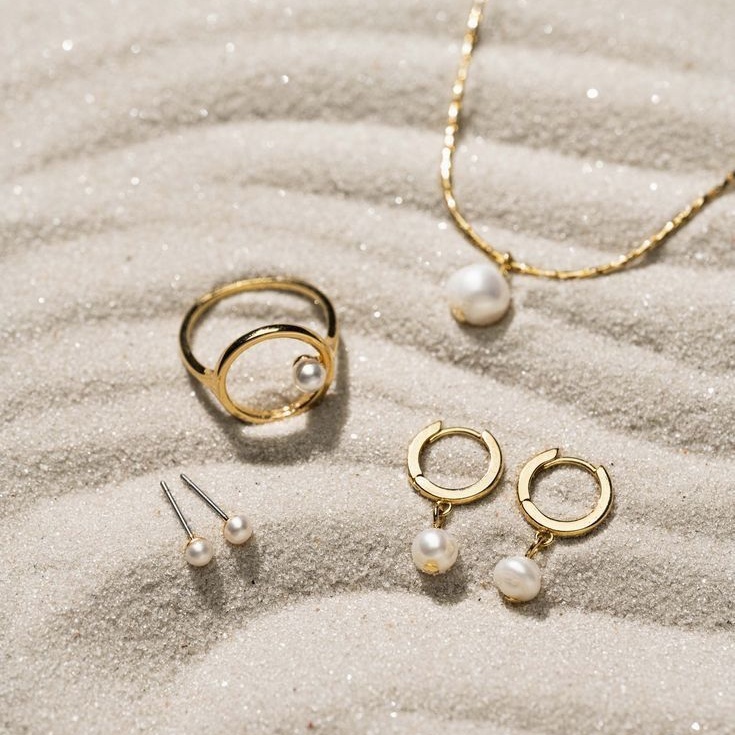
What Jewelry Can You Wear in the Ocean?
Ocean proof jewelry must be able to withstand saltwater corrosion, wave action, and varying temperatures while maintaining structural integrity. Below are some jewelry you can wear in the ocean:
Stainless Steel Jewelry
Is stainless steel waterproof enough? Can you wear stainless steel in the ocean just as you do in the pool? Yes.
The chromium content in stainless steel jewelry forms a self-healing passive layer that regenerates when damaged by saltwater exposure. However, after coming out of the ocean, rinse the jewelry with clean water to remove salt deposits that might build up to affect the surface finish, and dry it after use.
PVD Coating Stainless Steel Gold Jewelry
The strong gold layer on PVD coating stainless steel gold pieces prevents saltwater from reaching inside the jewelry.
Does gold stainless steel tarnish? No, it does not tarnish quickly. When Titanium Nitride (TiN) is used, the firmness of the gold layer to the stainless steel is harder, making the jewelry maintain its gold appearance despite prolonged exposure to the ocean. However, the PVD layer may fade if the coating is scratched or rubbed. If the PVD layer is rubbed, it can easily cause discoloration after soaking.
Solid Gold Jewelry
This salt water safe jewelry can withstand physical stresses from ocean activities. Higher karats are softer and may scratch more easily, while 14K and 18K offer better durability. Rinse with fresh water afterward to maintain its shine.
Gemstones That Are Pool Safe & Ocean Safe
Durable gemstones ranking from 7 above on the Mohs hardness scale are safe in the pool and ocean. They include:
- Diamond (10), Sapphire (9), and Ruby (9), which offer maximum scratch resistance and chemical stability.
- Emerald (7.5-8), which handles water exposure well despite natural inclusions.
- Tourmaline (7-7.5) and Quartz varieties like Amethyst (7), can resist chlorine and saltwater damage.
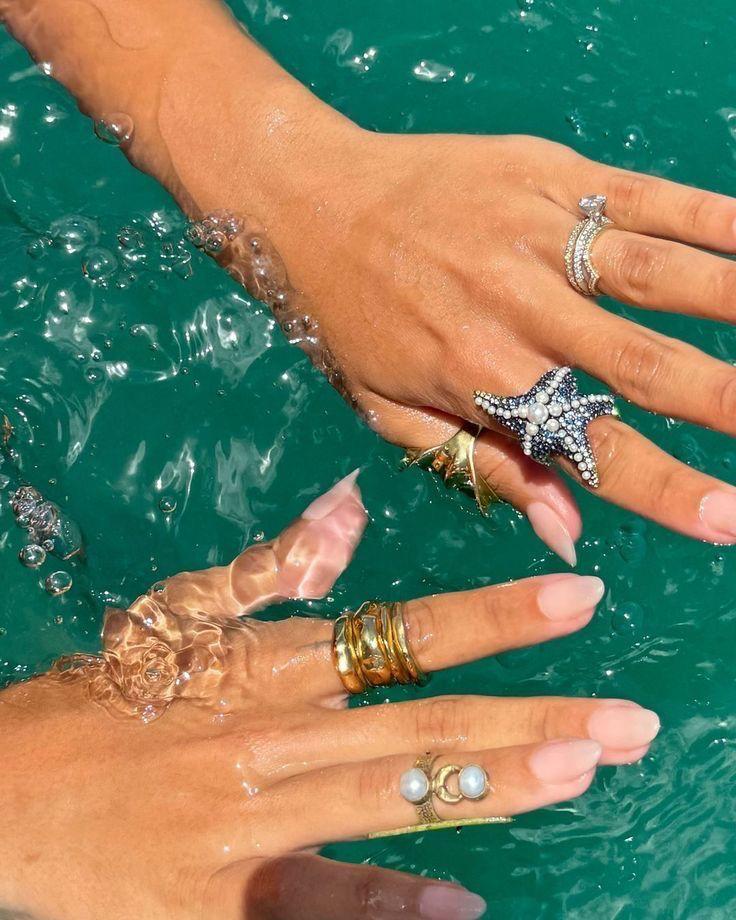
Can You Wear Stainless Steel Jewelry in the Pool & Ocean?
Yes, you can. Among all jewelry materials, stainless steel jewelry is the most reliable choice for showering and swimming in both the pool and ocean. Thanks to its chromium-rich protective layer, stainless steel resists corrosion, chlorine, and saltwater damage—making it truly waterproof jewelry that keeps its shine even after repeated exposure.
Can You Wear 14K/18K Gold in the Pool & Ocean?
Yes, 14K and 18K gold jewelry offer excellent durability and perform excellently in pools and oceans. They contain pure gold, which is chemically inert and withstands reactions to chlorine and saltwater.
Can You Swim With Gold Filled Jewelry?
Yes, you can. The substantial gold layer provides effective protection against pool chemicals and saltwater. But apply proper care and rinsing with clean water and dry it to extend the lifespan.
Can You Swim With Gold Plated Jewelry?
It depends on plating layer, proper handling and everyday wear and tear. Swimming with thin gold plated jewelry is not recommended, which can easily wear off from chlorine or saltwater exposure. Thick gold plated like gold filled is generally safe.
Does Stainless Steel Tarnish in Saltwater?
NO. Stainless steel without coating doesn’t tarnish in saltwater easily. in saltwater easily. The chromium content forms a protective oxide layer that prevents corrosion, making stainless steel highly durable even in marine environments.

Source: robertobravo
Tips for Jewelry Brands: Jewelry Styles That Recommend Using Stainless Steel
If your brand is focused on any of these markets below, stainless steel is the best option:
Ocean-Inspired Jewelry
Ocean-inspired jewelry benefits from stainless steel’s resistance to saltwater, which prevents tarnish and corrosion. This makes it ideal for seashell pendants, wave motifs, and other nautical designs worn at the beach.
Sports & Gym Jewelry
Sports and gym jewelry requires stainless steel’s sweat resistance and hypoallergenic properties. The material won’t tarnish from perspiration or cause skin irritation during workouts.
Swimsuit Accessories Jewelry
Swimsuit accessories benefit from stainless steel’s ability to withstand chlorine, sunscreen, and heat. This ensures poolside, resort, and summer-ready jewelry keeps a polished, long-lasting appearance.
Techniques to Achieve Pool Safe & Ocean Safe Jewelry
Explained below are the 2 major techniques that can be used by a professional custom jewelry manufacturer to make pool and ocean safe jewelry pieces:
- PVD Coating (Physical Vapor Deposition)
PVD coating is a high-tech process that applies a thin, durable layer of metal or alloy onto jewelry surfaces. It involves vaporizing a solid material in a vacuum chamber, which then bonds to the jewelry at the atomic level.
With a hard and durable TiN layer, PVD coating jewelry enhance jewelry’s color, scratch resistance, and corrosion protection, making it ideal for stainless steel than electroplating.
- E-Coating
E-coating uses electrical charges to attract polymer particles onto jewelry surfaces in water-based baths, creating uniform protective layers even in complex parts.
The benefits include superior adhesion, consistent thickness, and enhanced durability. Jewelry with e-coating can last at least 3 months longer than those without.
Conclusion
Looking great shouldn’t be restricted outside the ocean or pool. With ocean and pool safe jewelry, you can continue to look radiant inside the water without the fear that your jewelry is at risk. Choose any of the jewelry discussed above and rest assured that you will last long without tarnishing.
FAQs
It depends on the jewelry materials. You can wear when made with durable materials like 304 and 316L stainless steel.
No, freshwater pearls are not safe to wear in saltwater. The salt and minerals can damage their delicate nacre, causing dullness, discoloration, or surface erosion over time.
Yes, silver jewelry without rhodium plating or e-coating can tarnish in saltwater. Ensure that after every exposure to saltwater, you rinse them in clean water and dry them.
Stainless steel is the best jewelry for the sea because it resists rust, tarnish, and corrosion from saltwater. Its durability and low maintenance make it ideal for everyday water exposure.
Gold jewelry, especially high-karat gold, can withstand water better than some metals, but frequent exposure to chlorine and saltwater may dull its shine or weaken settings over time. Rinse and dry after swimming to maintain its luster.
Men’s jewelry made of stainless steel or titanium is safest for pool or ocean use. It’s waterproof, corrosion-resistant, and durable, making it perfect for swimming and daily wear without losing its shine.
